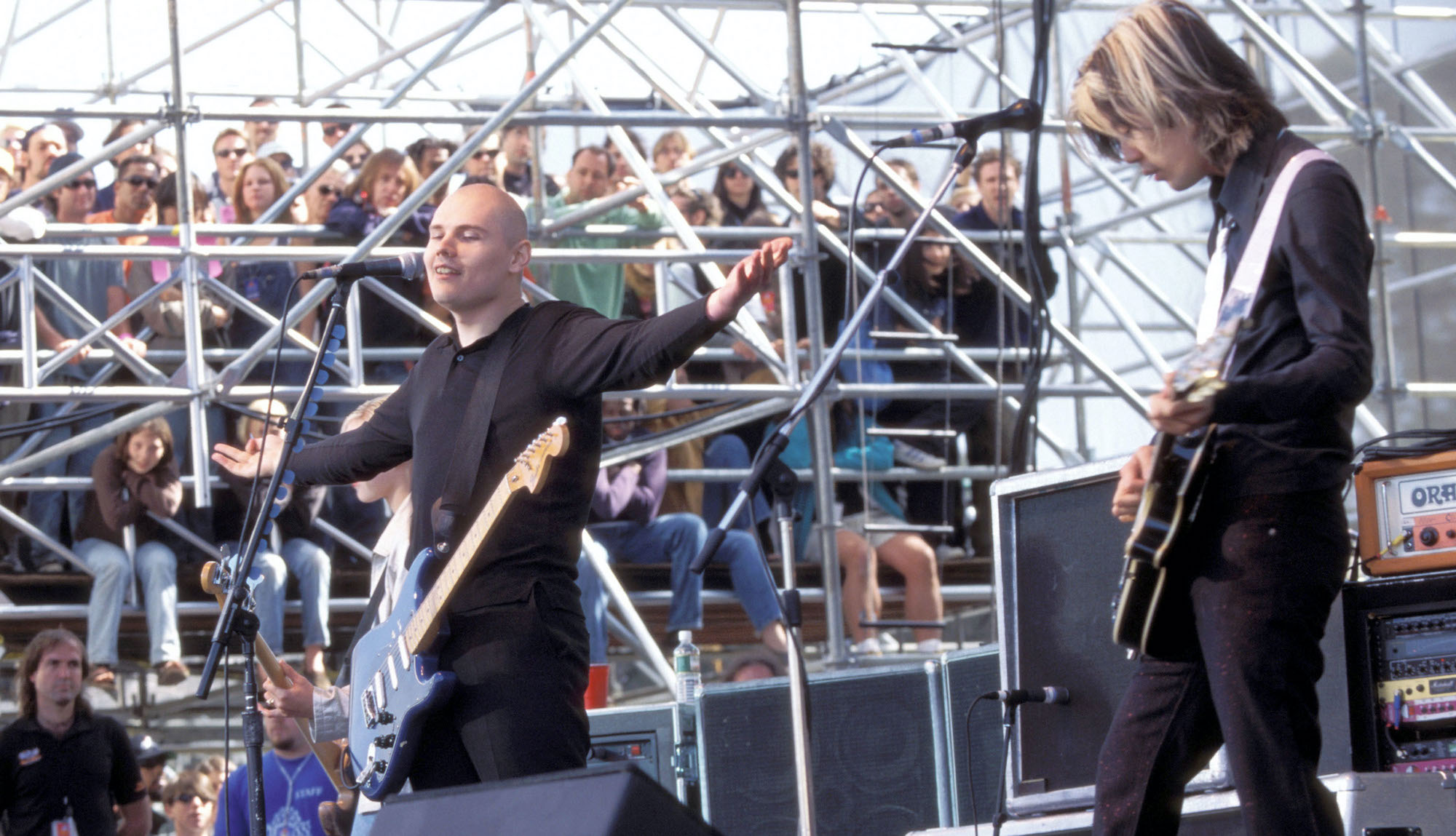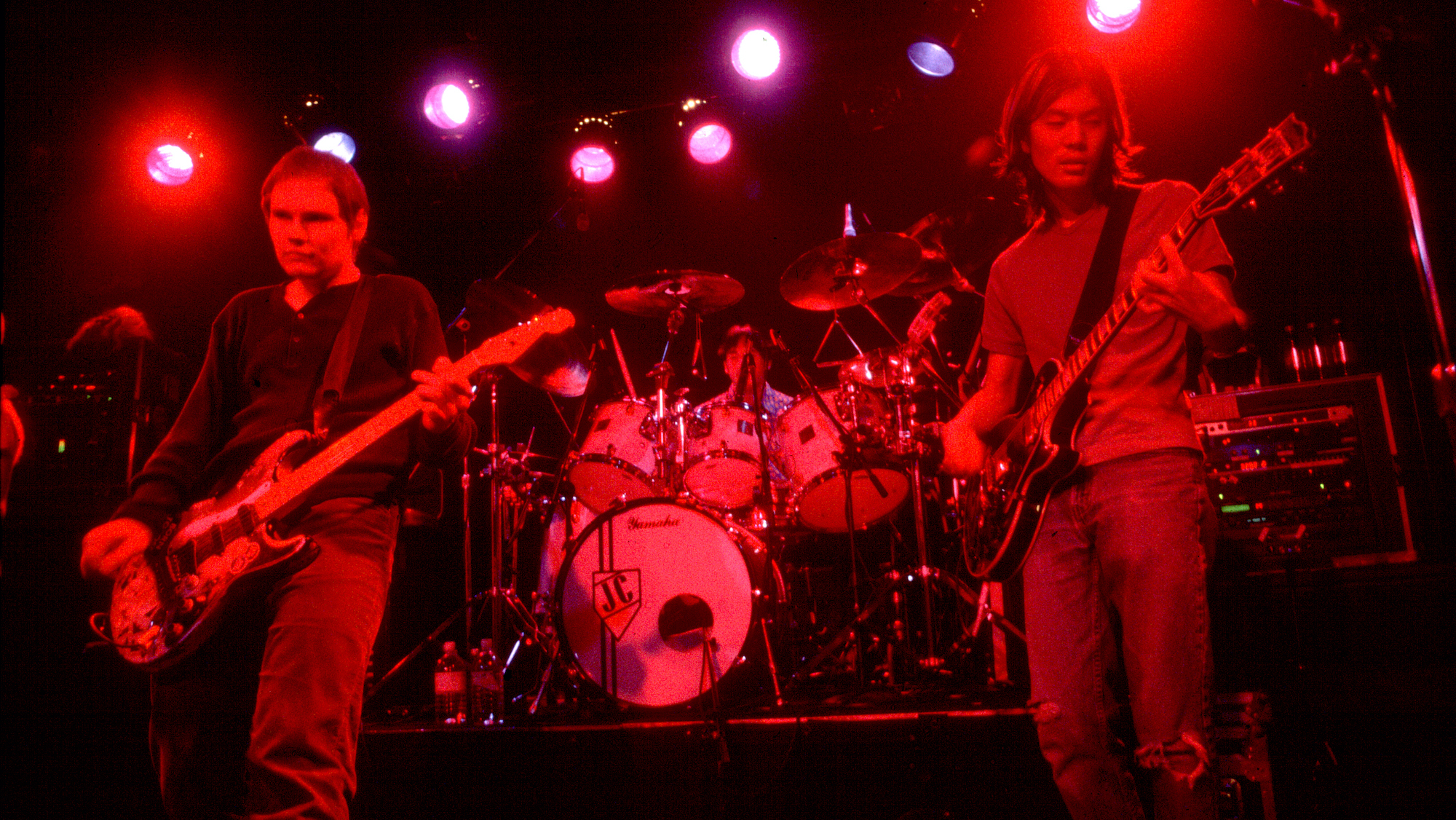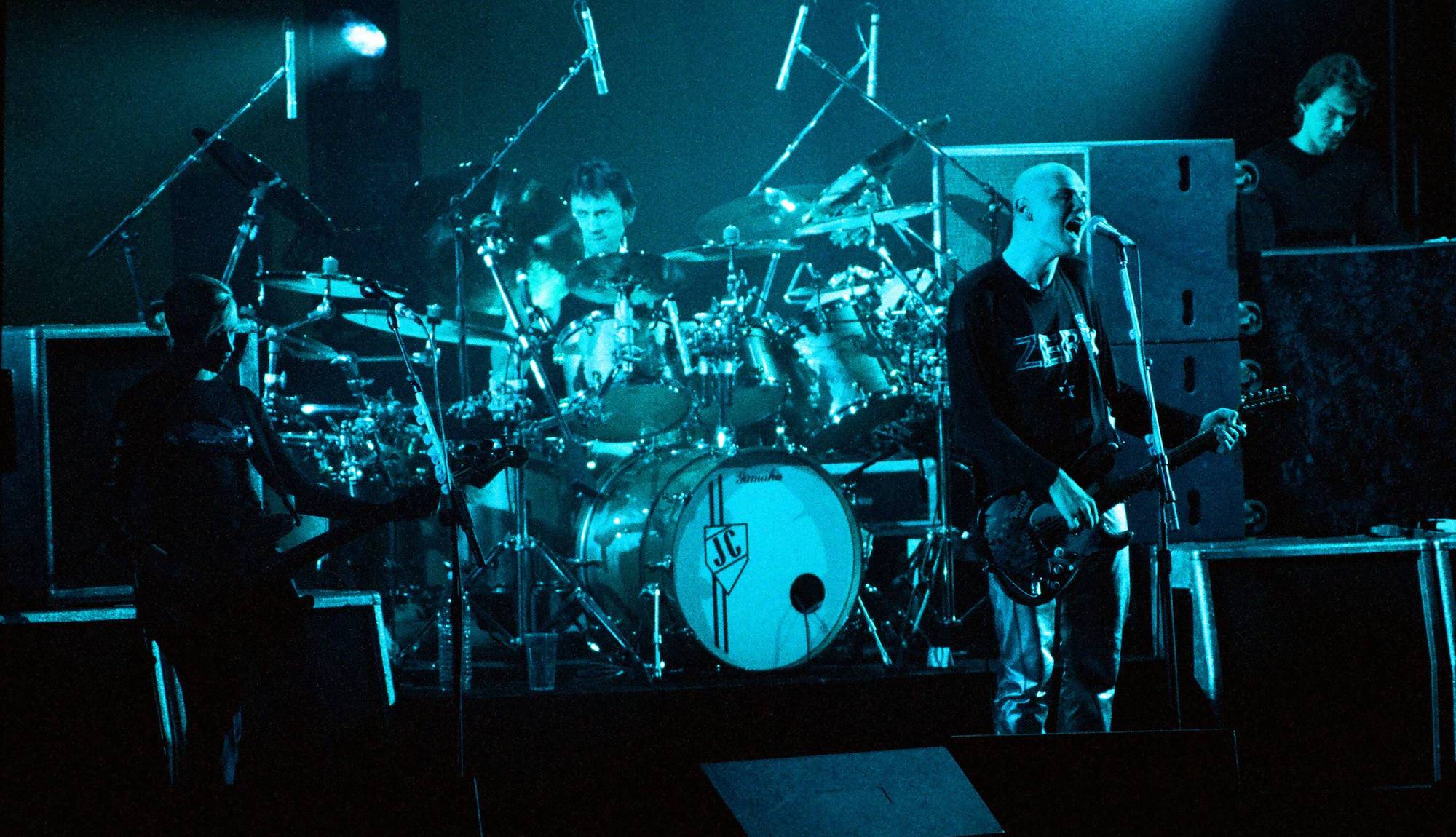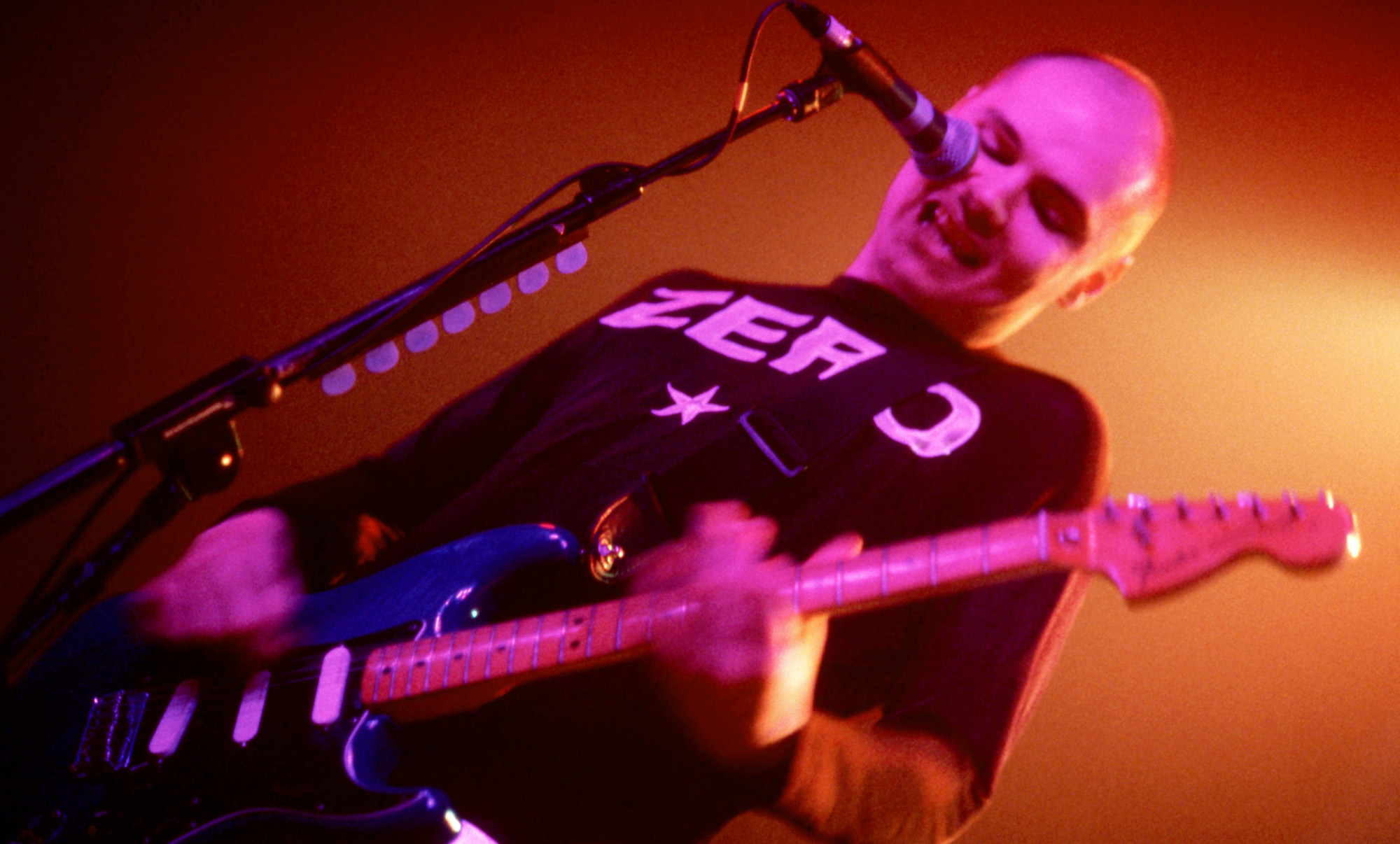"All we ever wanted to do in this band is kick people's ass": The Smashing Pumpkins on '80s Marshalls, epic guitar arrangements and their essential pedals
In this 1995 GW interview, Billy Corgan and James Iha discuss the gear that powered their sprawling, double-disc masterpiece, Mellon Collie and the Infinite Sadness

The following interview was featured in the December 1995 issue of Guitar World.
"Yep, we've played some really awful jams in this room." Billy Corgan laughs, his sweeping gesture taking in the wide expanse of the Smashing Pumpkins' rehearsal space.
Tucked away in a nondescript, red brick building in a dingy, working class section of North Chicago, the room is strewn with battle-scarred amps, guitars, some drums on a riser and stray bits of audio gear.
The head Pumpkin is dressed in a double-breasted, maroon corduroy jacket and boldly striped trousers that look as though they once hung in a wardrobe belonging to the late Rolling Stone Brian Jones. Corgan's wispy hair is dyed a glaring artificial auburn.
Like a lot of great, tortured songwriters, he seems ill at ease within his own body. His quiet, precise voice and deep, grayish-green eyes seem at odds with the tall, somewhat hulking frame he's been given for this lifetime – perhaps by some cosmic snafu.
Corgan is attended by an efficient-looking blond woman who silently dispenses vitamins, mineral water, fruit and all-around supportive vibes. The author of angst anthems like Disarm and Today seems almost cheerful – the genial host – as he leads me around the room, pulling out arcane, dust-encrusted fuzz pedals and guitaristic curios.
"We call this the Mayonaise guitar," he says, extracting a pawnshop special Kimberly from its case. "It's got those microphone pickups, you know? I bought it for 65 bucks and I've used it on about four songs, so I guess it's paid for itself." A mint-condition Hamer makes its appearance. "Rick Nielsen gave me this guitar. It's really nice."
Get The Pick Newsletter
All the latest guitar news, interviews, lessons, reviews, deals and more, direct to your inbox!
The old brick walls rising around Corgan may have endured some "really awful jams," as the guitarist alleges. But they've also witnessed some brilliant work. The Pumpkins' rehearsal space was the recording site for much of their new album, Mellon Collie and the Infinite Sadness, easily one of the most ambitious, epic records of this decade – a sprawling two-disc song cycle that flaunts the full scope of Corgan's songwriting prowess.
There's everything from piano ballads to the thrashy-trippy guitar rave-ups that have won the Pumpkins their honored place in the alternative rock pantheon. There are also moments of Beatles-esque music hall whimsy, of Queen-ish massed guitar grandeur, and trips to that sub-aquatic textureland where Prince and Jimi chase foxy mermaids through eternity.
Produced by the British dream team of Flood and Alan Moulder, the record is one whopping huge canvas, which Corgan and co-guitarist James Iha have covered with every guitar color at their collective command.

Guitar World: Did you know from the outset that this was going to be a big album?
Billy Corgan: "Yes. We almost had enough material to make Siamese Dream a double album. With this new album, I really liked the notion that we would create a wider scope in which to put other kinds of material we were writing."
If someone were to run a computer scan on the lyrics for this record, "belief" and "pretense" would certainly rank among the most commonly occurring themes.
Corgan: "I think that's a valid point. I think anyone in our position – i.e., in a successful rock band – is sensitive to the integrity issue. On the one hand, we have a rare opportunity to be creative and live a very exciting kind of life. On the other hand, we're basically asked to repeat the same thing over and over again, at a consistent level of quality.
"But great artists, of any time period, often find themselves in a position where people desire what they do so much that they're forced to repeat themselves. Jimi Hendrix used to play matinee shows, you know? And I think that's also symbolic of life. Everyone, not just people in bands, has to face the choice between living life to its fullest potential or going out and paying the bills."
With this new record, I think you've found a way not to repeat yourself, but still to satisfy people's expectations of a Smashing Pumpkins record.
Corgan: "Well, we really went into the record with the notion that this would be the last Smashing Pumpkins record. I mean, we plan on doing another record, but we don't plan on doing another record as the band that most people know. This kind of approach, style, music... everything is going to change."
Are you disbanding? Is that what you're saying?
"No, I'm saying we've reached the end of one creative ebb and flow. And it's time to go down a different musical path. Our options are either to disband, or that we will force ourselves to go in a different direction.
"We've got a lot of different viewpoints on the culture at the moment. We believe that, to a certain degree, we're taken for granted. It's hard to explain, but you just reach a point where you know it's time to move on."
How did you get involved with Flood?
James Iha: "Billy and I are both real big fans of his work. I'm sure both of us own at least 10 CDs that Flood has worked on. And they're all different. Not typical rock bands – all very individual."
One tends to think of him as a real sonic manipulator.
Iha: "That's the tag that people put on him – that he sits around with synthesizers all day. But he's not really about that. He knows how to do that stuff, but he's just as much into having a rock band play live in the studio. He's very open-minded."
Corgan: "Whatever works. We did things like sampling aerosol cans and the sound of scissors being opened and closed. On the song Cupid, all the percussion except the drum kit is stuff like this [Corgan picks up a jar of vitamins and shakes it rhythmically]. And it was real freeing, sonically."

Why didn't you work with [producer] Butch Vig this time, as you had on all your previous albums?
Corgan: "We'd become so close with Butch that it started to work to our disadvantage. It wasn't really a decision about him as a producer. I just felt we had to force the situation, sonically, and take ourselves out of normal Pumpkin recording mode."
Was it a challenge coming up with guitar arrangements for so many songs?
Corgan & Iha: [In unison] "Yeah."
Iha: "But here's what was cool about it: in the past, everything had to be overdubbed and layered – guitar overkill. That wasn't really the train of thought this time, although we did that too. But there's some songs with just one guitar track. The song To Forgive has just one live electric guitar take."
Corgan: "But then there'd be a song like Jellybelly, where Flood said, 'On this song, you need to do the Pumpkin guitar overdub army thing. You'll hurt the song if you don't.' So it was a good, healthy balance."
Were any core guitars or amps used to make the record?
Corgan: "It pretty much broke down to my live rig and the Siamese Dream setup, which is this Marshall head I have [an '84 JCM 800] that's literally been used on everything the Pumpkins have ever done. We call it the 'soul head.' I bought it off some stoner guy.
"The cabinet ended up being used on 90 percent of the guitar tracks for this album, and the head on about 30 percent. The other main rig was a Marshall rack preamp and Alesis compressor – which, for some reason, really sounds good with guitar – into a Mesa/Boogie head.
"That's the basic sound. And for a lot of stuff I used the same '57 reissue Strat that I did most of Siamese Dream on. We probably used 20 different electric guitars and 10 different acoustics on the album. We lined them all up in a row."
Iha: "Basically a lot of what we used was Strats and Les Pauls."
Corgan: "And of course we've got the full pedal army. Between the two of us, we've got 30 or 40 pedals."
What's the sickest pedal that you possess?
Corgan: "The Fender Blender. Kevin Shields [of My Bloody Valentine] told me to get one. It's just the destructo pedal of all time. Like if you listen to the song, Bullet [With Butterfly Wings], at about two-and-a-half minutes there's a part where the key changes and it comes in all loud and thick and the speakers sound real distort-y. That's that pedal."
Is all that front end gain from all those fuzz boxes the key to that super-saturated Smashing Pumpkins distortion?
Corgan: "To be honest with you, the basic sound on this album comes from that amp rig I told you about, with the Marshall preamp and Mesa/Boogie head. You just have to take time to tweak it to get the most gain out of that shit and then figure out how to get the most gain out of the combination of guitars you're using.
"I think most people do a very poor job of that. They get something that sounds like it's really exciting and distorted, but when you really listen to it, it's crap."
Iha: "That's the worst thing. All these alternative bands with big hits right now, they think if they buy a Big Muff and a Marshall stack, they're gonna get the Kurt Cobain sound. But they just don't know what to do with it."
It's the DX7 of the '90s.
Iha: "That's a very sad analogy."
So which song on the new album has the greatest amount of guitar tracks?
Corgan: "I think Thru The Eyes Of Ruby. In the end, I think Alan [Moulder] said there were 56 guitar parts on there."

Do you ever detune for things like Jellybelly – the chunka chunka thrash numbers?
Corgan: "Yeah, yeah, we use the 'grunge tuning.'"
Iha: "Dropped D – only the first string."
Corgan: "Yeah, but then we detuned everything on the album down a half step. So, like, the bottom string on the bass was E flat. And the dropped D stuff is really C sharp. We just wanted to make the music a little lower, that's all."
Do you guys have similar musical tastes? Do you share guitar heroes?
Corgan: "I think we're pretty much in agreement on the old stuff we like. We're both big fans of the same old bands, like Sabbath and the Jefferson Airplane."
God, you guys like the Jefferson Airplane?
Corgan: "The old stuff. They were pretty cool. Obviously, because of where and when we were born, I think we just sifted through a lot of music we'd heard about and found the stuff that we liked."
Iha: "It was cool to be rock geeks, 'cause then you found out what was actually good about all these old-school bands. But most kids today wouldn't give two shits to listen to all that stuff."
Smashing Pumpkins are one of the groups that re-legitimized heavy metal.
Iha: "I beg your pardon? Although there are some pretty good Judas Priest grooves on this new album."
You know what I mean. In interviews, you were among the first alternative rockers to mention people like Ozzy and Black Sabbath with anything other than contempt.
Corgan: "Well, I've always said that you can certainly quarrel with Black Sabbath's Satanic politics, or Judas Priest's pseudo leather-man aspects. But what drew me to that music as a kid wasn't what they were singing about – although that did hold a kind of kiddie fascination for me. It was mainly the music.
"Flood... okay, loves Pantera. When he found out I was a Pantera fan, he literally jumped up and down. I think it's really dumb when people try to make sound a political question. All we ever wanted to do in this band is kick people's ass. There's something funny about loud drums and rocking guitars that seems to assist that process."
In a career that spans five decades, Alan di Perna has written for pretty much every magazine in the world with the word “guitar” in its title, as well as other prestigious outlets such as Rolling Stone, Billboard, Creem, Player, Classic Rock, Musician, Future Music, Keyboard, grammy.com and reverb.com. He is author of Guitar Masters: Intimate Portraits, Green Day: The Ultimate Unauthorized History and co-author of Play It Loud: An Epic History of the Sound Style and Revolution of the Electric Guitar. The latter became the inspiration for the Metropolitan Museum of Art/Rock and Roll Hall of Fame exhibition “Play It Loud: Instruments of Rock and Roll.” As a professional guitarist/keyboardist/multi-instrumentalist, Alan has worked with recording artists Brianna Lea Pruett, Fawn Wood, Brenda McMorrow, Sat Kartar and Shox Lumania.
“The rest of the world didn't know that the world's greatest guitarist was playing a weekend gig at this place in Chelmsford”: The Aristocrats' Bryan Beller recalls the moment he met Guthrie Govan and formed a new kind of supergroup
“We hadn’t really rehearsed. As we were walking to the stage, he said, ‘Hang on, boys!’ And he went in the corner and vomited”: Assembled on 24 hours' notice, this John Lennon-led, motley crew supergroup marked the beginning of the end of the Beatles



![[from left] George Harrison with his Gretsch Country Gentleman, Norman Harris of Norman's Rare Guitars holds a gold-top Les Paul, John Fogerty with his legendary 1969 Rickenbacker](https://cdn.mos.cms.futurecdn.net/TuH3nuhn9etqjdn5sy4ntW.jpg)







